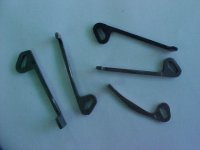Deerinator
New member
Malumute- Again thanks for the weath of information. I'm gonna do some dry firing today and maybe some light shooting. 50 rounds or so. And see if i can't become a threat at 35 yards.
If by chance the firing pin does go bad during the dry firing period are they easy to replace. They looked rivited in place. Has anyone ever had to replace one of these?
I figured 38's were to small for deer but i figured i'd ask. Now you said use this for small game and the only small game abudance here in MI is squirrels and rabits which would blow those things away wouldn't it we also have the occasional woodchuck and coyote but being that turkey season is apon us i don't know if the local DNR would believe that i was just varmit hunting during turkey season. Might have to check out the laws on that.
For deer the reason i bought this gun was it was easy to hold steady for me and i wanted a light secondary gun in the stand so if a doe did present herself close i could then take my first deer with a pistol. But your right for the 100 yard mark i would be better sereved with a 44 or heck a 454/480 setup but i don't need a dinasour gun just a deer gun.
Thanks for you help. I'll post back if it stops raining enough for me to go out and shoot today. WERE SUPPOSED TO GET SNOW TONIGHT! In the lower up geez just when you think winter has finally giving up.
If by chance the firing pin does go bad during the dry firing period are they easy to replace. They looked rivited in place. Has anyone ever had to replace one of these?
I figured 38's were to small for deer but i figured i'd ask. Now you said use this for small game and the only small game abudance here in MI is squirrels and rabits which would blow those things away wouldn't it we also have the occasional woodchuck and coyote but being that turkey season is apon us i don't know if the local DNR would believe that i was just varmit hunting during turkey season. Might have to check out the laws on that.
For deer the reason i bought this gun was it was easy to hold steady for me and i wanted a light secondary gun in the stand so if a doe did present herself close i could then take my first deer with a pistol. But your right for the 100 yard mark i would be better sereved with a 44 or heck a 454/480 setup but i don't need a dinasour gun just a deer gun.
Thanks for you help. I'll post back if it stops raining enough for me to go out and shoot today. WERE SUPPOSED TO GET SNOW TONIGHT! In the lower up geez just when you think winter has finally giving up.



